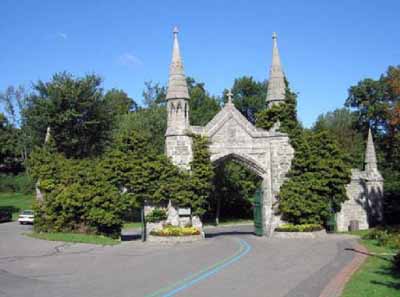Mount Royal Cemetery National Historic Site of Canada
Montréal, Quebec

General view
© Parks Canada/Parcs Canada 2004.
Address :
1927 Forest Road, Montréal, Quebec
Recognition Statute:
Historic Sites and Monuments Act (R.S.C., 1985, c. H-4)
Designation Date:
1999-05-04
Dates:
-
1852 to 2009
(Construction)
-
1852 to 1852
(Significant)
-
1901 to 1901
(Significant)
-
1847 to 1847
(Established)
Event, Person, Organization:
-
William C. Macdonald
(Person)
-
Richard Sprigings
(Person)
-
James C. Sidney
(Architect)
-
Ormiston Roy
(Architect)
Other Name(s):
-
Mount Royal Cemetery
(Designation Name)
Research Report Number:
1998-038, 38A
Plaque(s)
Existing plaque: 1927 Forest Road, Montréal, Quebec
This cemetery is an exceptional example of rural cemetery aesthetics originally popular in the United States in the 19th century. Laid out in 1852, it is characterized by winding roads and many wooded groves that create a series of landscaped vistas out of which the monuments emerge. Located outside the original city limits, on the north slope of the mountain, it solved the problem of overpopulated urban cemeteries. This picturesque setting, with its funerary monuments of considerable artistic and historical interest, invites contemplation and remembrance.
Description of Historic Place
The Mount Royal Cemetery National Historic Site of Canada is located on the northern slope of Mount Royal in the Outremont borough of Montréal, Québec. Opened in 1852, the 67-hectare cemetery was designed in a Picturesque style reminiscent of early 19th-century rural cemeteries in France and the United States. The terraced grounds of the cemetery are landscaped with islets of flowers and mature trees and contain many commemorative monuments and sculptural grave markers of varying styles and sizes. The site also features several associated buildings including the director’s residence and crematorium. Official recognition refers to the cemetery in its defined boundaries, including landscape elements, pathways, tombstones and funerary monuments.
Heritage Value
The Mount Royal Cemetery was designated a national historic site of Canada because: since its establishment in 1852, this cemetery is an exceptional example of the aesthetics and design attributed to rural cemeteries in the 19th century; several of the funerary monuments in the cemetery are of exceptional historical, social, architectural or artistic value. The monuments are a remarkable illustration of the many facets in the history of Montréal, the Province of Quebec and Canada.
The Mount Royal Cemetery was incorporated in 1847 and consecrated in 1852 as a Protestant cemetery and was designed by architect James C. Sidney according to the Picturesque principles of the early 19th-century rural cemetery movement. Its arrangement includes natural features, winding paths, irregular islets of flower beds and mature trees that are integrated with the funerary monuments to create a series of landscaped vistas. The cemetery also features a wide range of funerary monuments, including 12 mausoleums, one of which is associated with the Molson family, and a wide-range of smaller funerary monuments, including that of General Sir Arthur Currie. Its park-like design and panoramic views emphasize the dominance of nature in the cemetery and would become a model for subsequent rural cemeteries in Canada.
Source: Historic Sites and Monuments Board of Canada, Minutes, December 1998.
Character-Defining Elements
Key elements contributing to the heritage value of this site include: its location on the north side of Mount Royal in the Outremont borough of Montréal, Québec; its rural design and natural setting, reminiscent of the design of rural cemeteries pioneered in France and the United States at the beginning of the 19th century; its rolling topography dominated by natural features, particularly diverse varieties of trees, shrubs, small ponds and lakes; the winding paths which surround the irregular curvilinear shapes of the islets; the abundance and variety of the funerary monuments which range in style, size and materials, which have historical associations for the city, province or nation; the monumental gatehouse and entranceway, flanked by two towers; the associated buildings and structures, including the director’s residence, the charnel houses and the 1901 crematorium with adjoining mausoleum, chapel and columbarium; its geographic relationship with the Catholic cemetery of Notre-Dame-des-Neiges; the continued association of the site with its archival and archaeological objects collection; the panoramic viewscapes of the city of Montréal and the cemetery from the summit of Mont Royal.